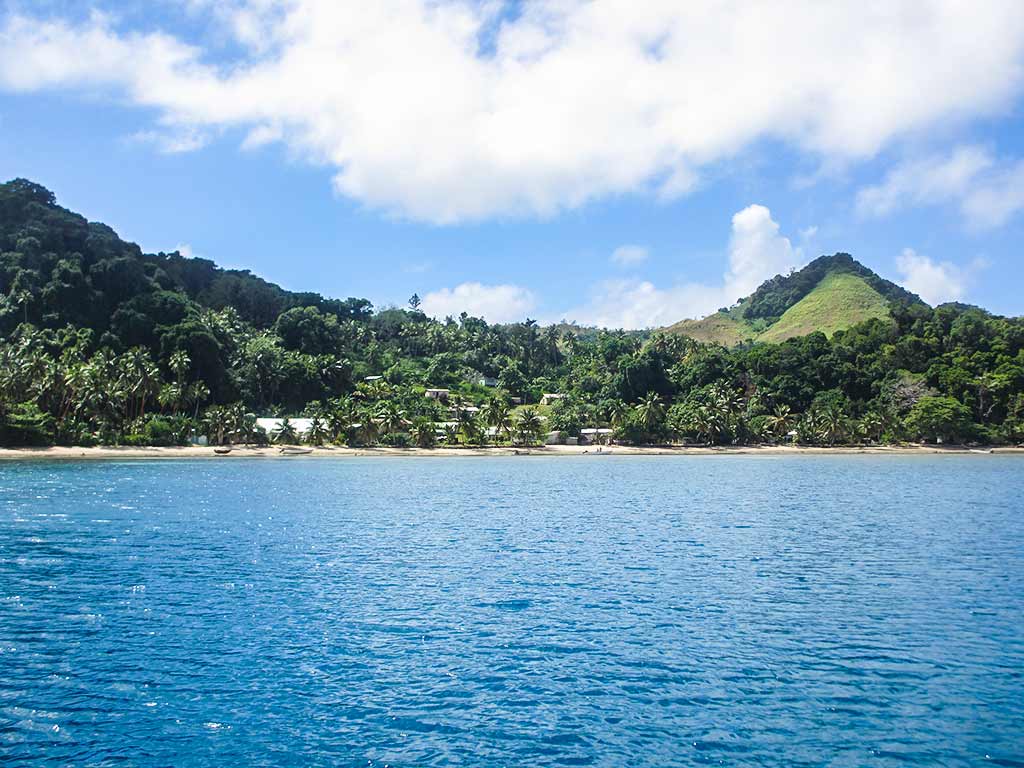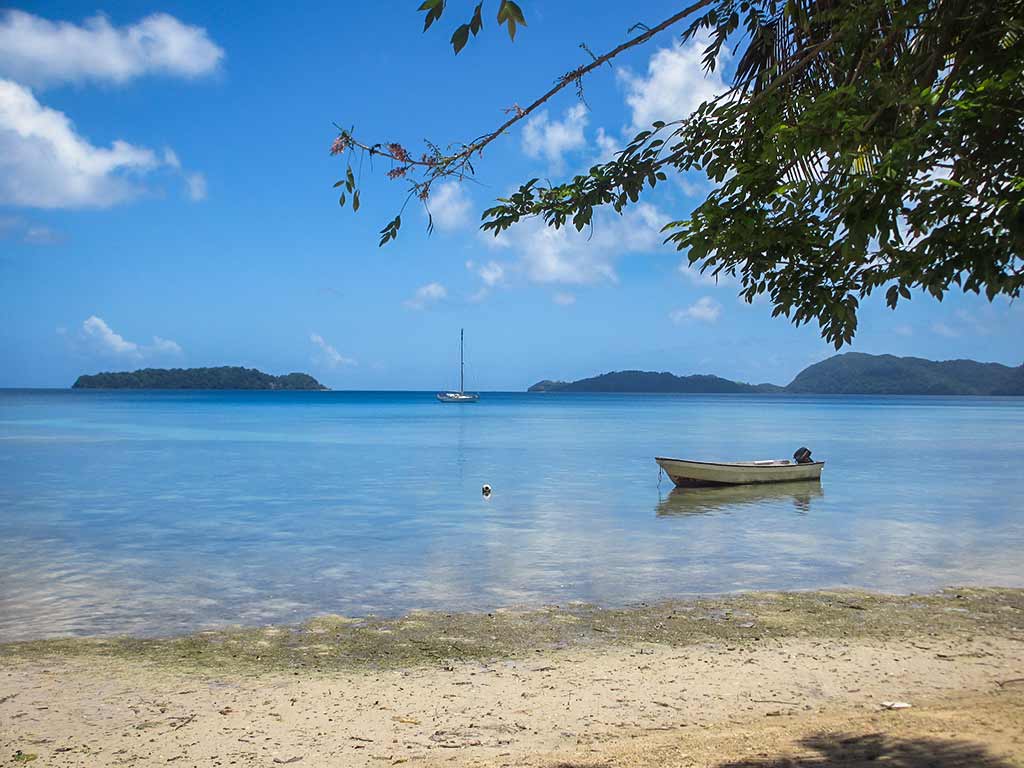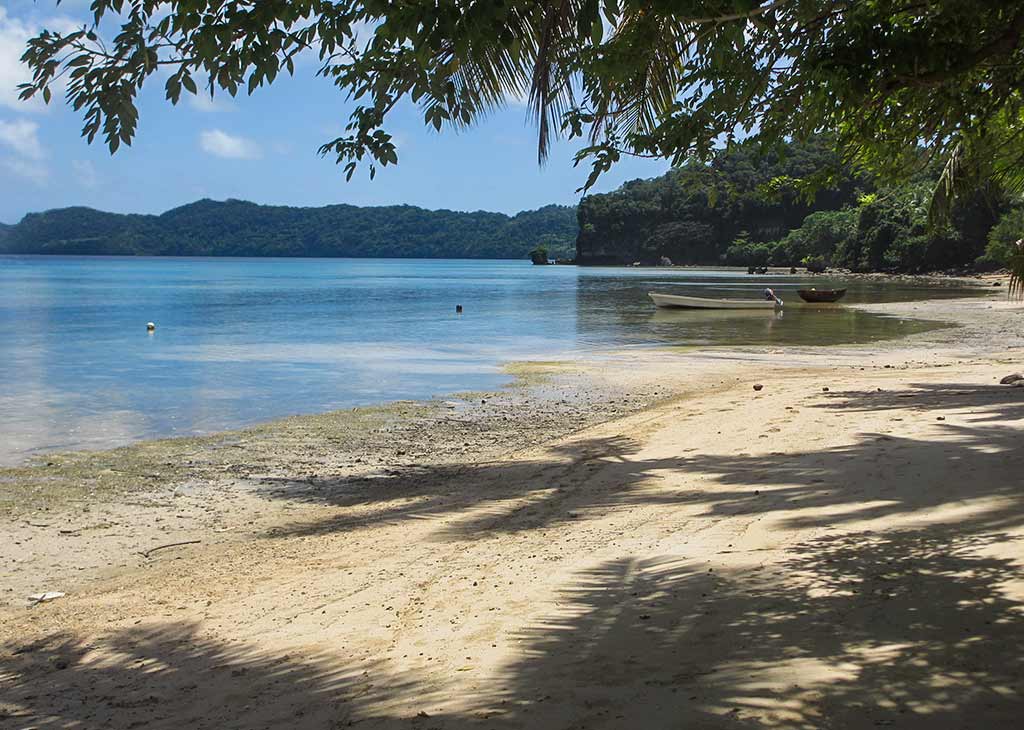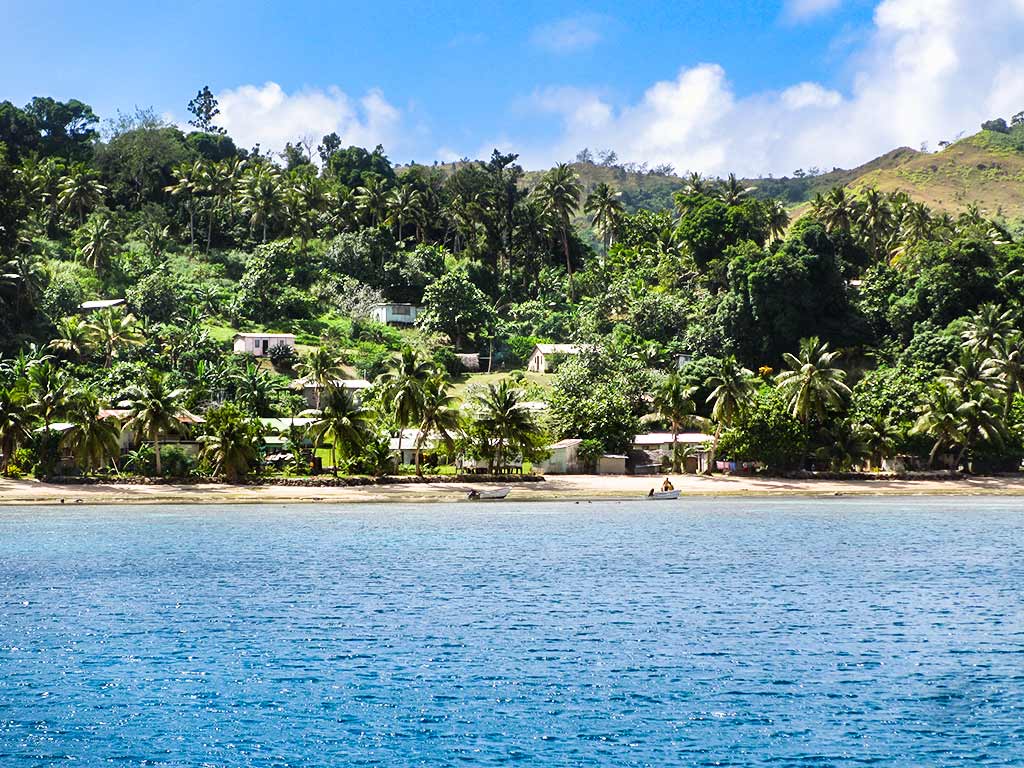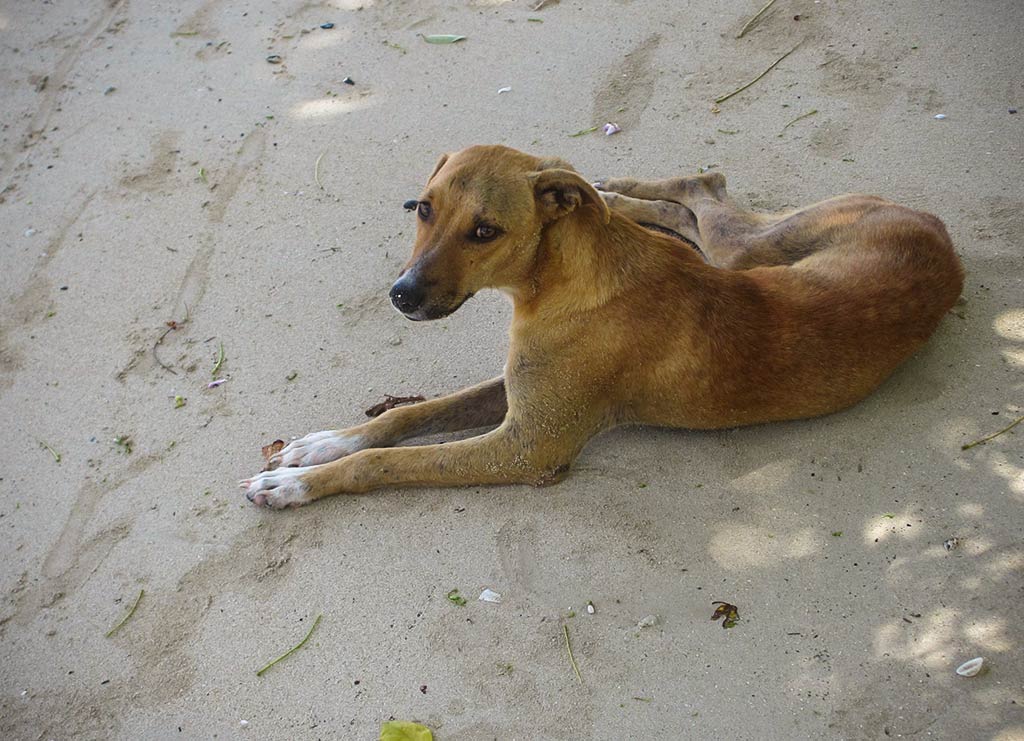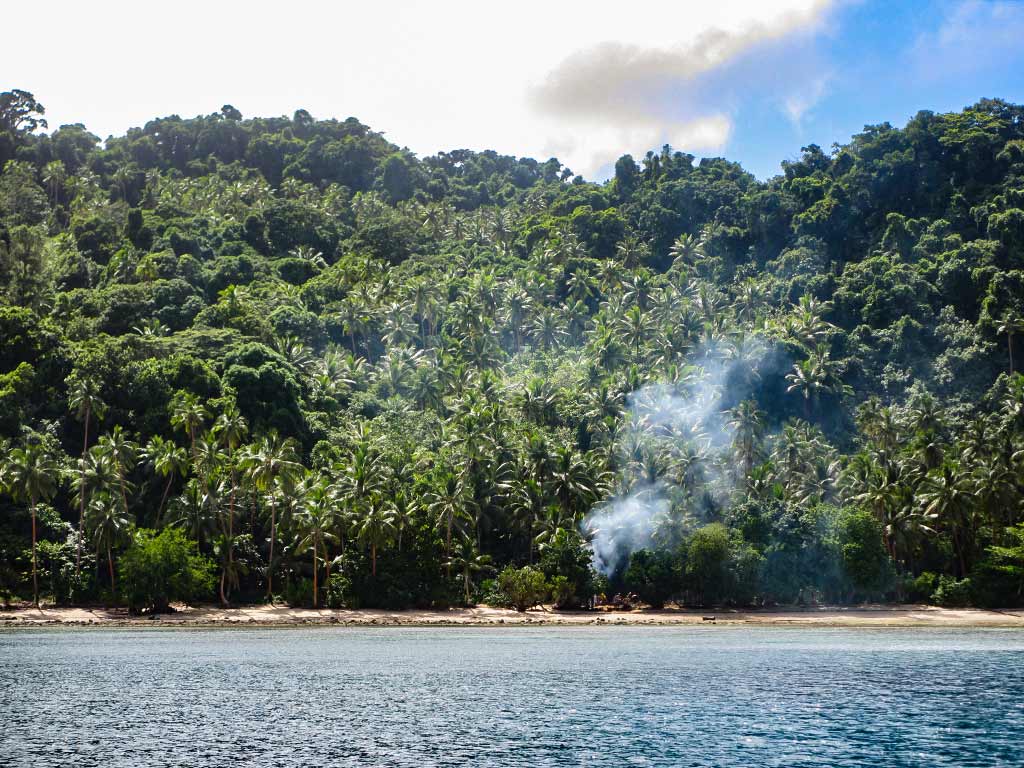September 17, 2013
We woke up pretty early and went outside to have coffee and survey our new surroundings. This is one of my favorite parts of cruising: seeing a new neighborhood in the morning light, often seeming very different after a cloudy, tired, late-afternoon arrival.
Unfortunately we wouldn’t be in this spot long because we needed head about a mile up the coast to an anchorage off Dalconi Village. We didn’t look forward to making this trip as Dalconi’s anchorage has poor holding and protection, but we needed to go there to do a sevusevu ceremony to gain access to the north part of this island.
As we motored north, we had a few impressive blasts of wind barrel down on us. This island is mountainous, and often that means wind bullets, almost as if the wind builds up at the top of the mountain then topples over in one big blast. There isn’t much effect on the water, but it is unnerving to be motor-sailing along minding your own business and suddenly finding yourself heeled way over.
Once we arrived at the village, we had a problem with our windlass and anchor. Rich fixed it, and we finally got the anchor set, but this was not turning out to be a good day. Earlier we’d found a container leaking oil in our lazarette, an annoying mess we’d have clean up. And now the psychic weight of having to do a sevusevu was putting enough stress on us to make us bicker over inconsequential things (we tend to bicker when under stress). Emotionally, bad things were piling up, and things were about to get worse.
As we anchored we noticed some guys had been building a fire pit on the beach. We assumed it was for trash until we heard a pig snorting, then screaming. Rich and I looked at each other. The screaming went on about 15 seconds, then subsided into softer grunts, then silence. Apparently this was to be a lovo (an feast cooked on hot stones underground) and the main dish had just been put to death.
Tears sprung to my eyes; this was an extra horrible event on a pile of bad events. I was upset and crying when I came back to the cockpit. Rich said I’d end up a vegetarian, but I said no, I wouldn’t. But I didn’t like hearing something suffer and die like that.
I pulled myself together and we somberly got ready to head in, me wearing a sulu (like a sarong) and Rich wearing long pants (men have an option to wearing the male version of a sulu which Rich really never wants to do). We put our kava in my backpack, it’s long shoots sticking out the top making a nice visual announcement that we were properly prepared.
We got in the dinghy and our electric engine wouldn’t start. We switched batteries and still no luck. Rich cleaned the contacts, then worked at it and finally got it started. We thought we’d fixed this thing but it was now going downhill steadily.
This day was not going well. Getting the dingy to shore required taking it over shallow water and rowing (never a good thing for us–we don’t row well together – see “Yelling Sticks”). We scraped the bottom in spite of the rowing but thankfully the dinghy seemed ok. This whole sevusevu excursion was turning out to be about as much fun as dental surgery.
Things started looking up when we arrived ashore to find two men waiting for us, one of them being Sam, the guy who acts as Turaga ni koro for this village. They’d seen us come in yesterday and tried to contact us over the radio (which we didn’t hear). A bit embarrassed as apparently boats are expected to come straight to Dalconi Village, we explained that we’d been ill yesterday and unable to come in (I didn’t go so far as to mention my racoon face). They accepted that and were very nice. It’s probably hard for a Fijian to be cross with someone with a peacock-like display of kava roots sticking up behind her head.
The sevusevu went really well. We all sat down on a mat at the chief’s house and Sam presented our kava and our $60 ($30 per person), the pre-set fee for visiting the Northern Lau Group of islands, specifically an area called the Bay of Islands which happens to be owned by Dalconi Village. We were presented with an agreement that showed a list of projects for which the money would be used.
Apparently Dalconi Village had gotten some resistance from cruisers not wanting to pay the fee, fueled by the likes of Curly (the local ex-pat who does seminars about how to cruise Fiji) and John Martin (head of the ICA rally who is quite an expert on charging fees for no service) who feel there should be no fee here at all. So they now call it a “donation,” and show you how your donation will be used for things like the school or community building, etc. For heaven’s sake, what else are they going to use it for, drugs and hookers? Somehow this list allows for cruisers to save face, thinking they are standing up and refusing to pay the fee but are instead making a donation (for the suggested amount, of course). Excuse me while I go roll my eyes.
We made our “donation,” then looked at some info they have about a cave excursions and feasts, although I think these things take place earlier in the season when there are more cruisers. Sam then took us around the village and to visit his house. He asked what we needed, and we said bananas and papayas and we’d be happy to pay for both. They had no bananas, but they did have papayas and they would be free for us. At his home he apologized that his wife was not there to cook us lunch but did give us some breadfruit cooked over an open fire that was quite good. He told us how to cook it, and then actually gave us some. In all we found Sam exceedingly generous and gracious, and I felt bad about the flack they’ve endured about charging the fee. After all, until recently, visiting the Lau group of islands required an outrageously expensive special permit. Now at least it’s affordable and accessible. (Below, a gallery of photos from Dalconi Village; click to enlarge/scroll.)
Our sevusevu and village visit went well and the spell of bad events for us seemed to have been broken, but when we took our dinghy back in the water, my shoe stuck in the mud and broke. This was followed by another spat over who was and wasn’t rowing properly through the water. (I was rowing properly, Rich was not, but he yells louder.) Back on the boat I managed to pinch some skin on my palm as I closed the overhead hatch, quite painful and soon to be a nasty blood blister. The bad ju-ju seemed to be back.
We pulled up our anchor and headed back to our previous anchorage off Malaka. Sam had told us how to take a bus to the main town located on the other side of the island. Since we needed some provisions, we planned to head in the next morning and catch the bus at a stop just outside the Malaka village. As for now, it was good to be back in our old, secure spot: good holding in a protected anchorage.
I know this has been a long, rambling post, but I have a reason for writing it. Recently I did a post about a perfect day we’d had, but frankly those aren’t as frequent as non-cruisers like to think. Most days tend to be more of a mixed bag. Sometimes the mix leans towards the positive, sometimes more to the negative (like the one above).
Really bad days happen, but they’re rare. Perfect days happen, but they’re also rare. Most days land in the middle. For me, the trick in life is to do what you can to make things happen more on the positive side of the middle, but sometimes shit happens and you just have to ride it out.–Cyndi

